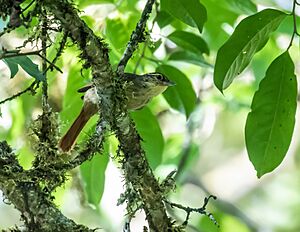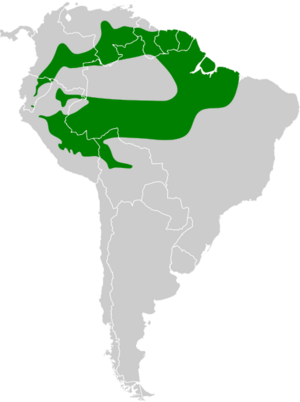Rufous-tailed foliage-gleaner facts for kids
Quick facts for kids Rufous-tailed foliage-gleaner |
|
|---|---|
 |
|
| Conservation status | |
| Scientific classification | |
| Genus: |
Anabacerthia
|
| Species: |
ruficaudata
|
 |
|
| Synonyms | |
|
Philydor ruficaudatus |
|
The rufous-tailed foliage-gleaner (scientific name: Anabacerthia ruficaudata) is a cool bird from the ovenbird family, Furnariidae. It's known for its reddish-brown tail. You can find this bird in several South American countries. These include Bolivia, Brazil, Colombia, Ecuador, Guyana, Peru, Suriname, and Venezuela. It might also live in French Guiana.
Contents
What is a Rufous-tailed Foliage-Gleaner?
This bird is a medium-sized member of the ovenbird family. It has a special bill shaped like a wedge. Both male and female birds look very similar.
How Big is This Bird?
The rufous-tailed foliage-gleaner is about 16 to 17 centimeters (6 to 7 inches) long. It weighs between 21 and 32 grams (0.7 to 1.1 ounces). That's about the weight of a few pencils!
What Does This Bird Look Like?
The rufous-tailed foliage-gleaner has a wide, creamy-yellow ring around its eyes. It also has a thin, buff-yellow stripe above its eye. A dark olive line runs behind its eye. Its cheeks and ear areas are olive-brown with yellowish streaks.
The top of its head is dark olive with faint lighter spots. Its back and rump are also dark olive. The feathers covering its tail are dark olive with reddish-brown tips. Its tail is a bright reddish-brown color. Its wings are mostly dark olive-brown.
Its throat is buff-yellow with some darker spots. Its chest is a dull buff-yellow with faint olive streaks. The belly is also dull buff-yellow with very light streaks. Its sides and the feathers under its tail are a bit darker and more olive.
Its eyes are brown. The top part of its beak is blackish to grayish. The bottom part is a lighter greenish-gray to olive-green. Its legs and feet are yellowish-brown to olive-green.
Younger Birds Look a Bit Different
Young rufous-tailed foliage-gleaners have a clearer, more orange-yellow stripe above their eye. Their upper parts are browner, not as olive. Their underparts are darker and less yellowish than adult birds.
Different Types of Rufous-tailed Foliage-Gleaners
There are three main types, or subspecies, of this bird. They look very similar but have small differences:
- A. r. ruficaudata: This type is the main one described above.
- A. r. subflavescens: This type has a clearer yellow throat. It also has less noticeable streaks on its underparts.
- A. r. flavipectus: This type has a more orange-yellow stripe above its eye and ear feathers. It has a darker yellowish throat and more yellowish underparts.
These different types often mix, so you might see birds with features from more than one type!
Where Does This Bird Live?
The rufous-tailed foliage-gleaner lives in different parts of South America. Each subspecies has its own area:
- The main subspecies, A. r. ruficaudata, is found in southeastern Amazonian Brazil, southeastern Peru, and northern Bolivia.
- A. r. subflavescens lives in northeastern Ecuador and eastern Peru.
- A. r. flavipectus is found in southeastern Colombia, southern Venezuela, Guyana, Suriname, and northeastern Brazil. It might also be in French Guiana, but this is not fully confirmed.
What Kind of Home Does it Like?
This bird prefers tropical lowland evergreen forests. It also lives in forests that flood during certain seasons. It mostly lives in "terra firme" forests, which are on higher ground and don't flood. Sometimes, it can be found in tall "várzea" forests, which are floodplains.
You'll usually find this bird below 850 meters (2,800 feet) in elevation. However, it can go up to 900 meters (2,950 feet) in Brazil and even 1,300 meters (4,265 feet) in Venezuela.
How Does This Bird Behave?
Movement and Migration
The rufous-tailed foliage-gleaner stays in the same area all year round. It does not migrate to different places.
What Does This Bird Eat?
This bird eats many different kinds of arthropods. These include grasshoppers, beetles, true bugs, and spiders. It usually forages alone or in pairs. It almost always joins groups of different bird species that feed together.
It looks for food from the middle to the top of the forest trees. It "gleans" its prey, meaning it picks insects off surfaces. It especially likes to find food on dead leaves. It also searches on live leaves, epiphytes (plants that grow on other plants), vines, and moss.
Reproduction and Life Cycle
Scientists do not know much about how the rufous-tailed foliage-gleaner reproduces or its life cycle. More research is needed to understand this part of its life!
What Does This Bird Sound Like?
The song of the rufous-tailed foliage-gleaner is described as a loud, fast series of notes. It can have up to 25 "te" or "ke" sounds. The song might go down in pitch and speed up at the end, or stay on the same pitch while speeding up, then slowing down slightly. It also has a more varied song that sounds like "wt-pt-pt, wit-wit-wit, d-d-d-d-d-d-d-d-d".
Its call, especially in Brazil, is a very short, dry rattle, like "krrreh". This call has not been described in other places yet.
What is the Status of This Bird?
The IUCN (International Union for Conservation of Nature) says the rufous-tailed foliage-gleaner is a species of "Least Concern." This means it's not currently in danger of disappearing. It lives in a very large area. However, we don't know exactly how many of these birds there are. Scientists believe their numbers might be going down. No immediate big threats have been found for this bird. It is considered rare in some places but common in others. It also lives in several protected areas, which helps keep it safe.
Images for kids



